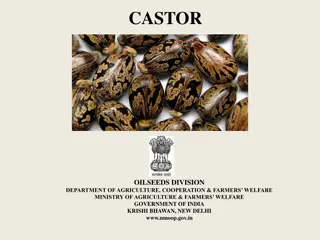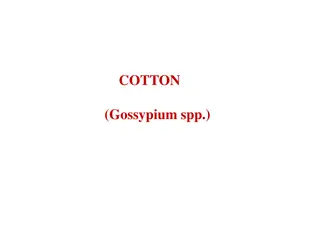Cultivation and Production of Cinnamon Oil from Cinnamomum zeylanicum
Cinnamon oil, derived from the dried inner bark of Cinnamomum zeylanicum trees, has various uses and applications. This article discusses the cultivation and production process of cinnamon oil, including propagation methods, harvesting techniques, and drying processes to obtain the final product. With a focus on sustainable practices and quality control measures, the narrative provides insights into the commercial cultivation of cinnamon oil and its significance in the pharmaceutical and aroma industries.
Download Presentation

Please find below an Image/Link to download the presentation.
The content on the website is provided AS IS for your information and personal use only. It may not be sold, licensed, or shared on other websites without obtaining consent from the author. Download presentation by click this link. If you encounter any issues during the download, it is possible that the publisher has removed the file from their server.
E N D
Presentation Transcript
BP504 T. PHARMACOGNOSY AND PHYTOCHEMISTRY II (Theory) UNIT-II General introduction, composition, chemistry & chemical classes, biosources, therapeutic uses and commercial applications of following secondary metabolites: Volatile oils : Mentha, Clove, Cinnamon, Fennel, Coriander 1
Cinnamon Oil Synonym: Cinnamon bark; Kalmi-Dalchini, Ceylon cinnamon Biological Source: Dried inner bark of the shoots of coppiced trees of Cinnamomum zeylanicum , (Syn. Cinnamomum verum ), family Lauraceae. Should not contain < than 1.0% of volatile oil. Geographical Source: evergreen tree of tropical area, native of Sri Lanka and Malabar coast of India. found in Jamaica and Brazil. Most of the world requirements met by Sri Lanka & hence true cinnamon is known as Sri Lanka cinnamon. 2
Cultivation Cinnamon Oil can be propagated by planting the cuttings and layers Commercially, propagated by seed Needs sandy or siliconous soils, humus. Altitude 800 to 1000 metres. Sheltered situation, annual rainfall of 200 - 250 cm. Seeds sown prepared nursery beds in June and July, distance of 10 cm, covered with small layer of soil and watered properly. 20 days for germination of seeds. allowed to grow for about 10 12 M Transplantation-in Oct./Nov. or in rainy season, distance of 2 meters b/w 2 plants. Shades provided with the pendals of coconut leaves. weeded 2 - 4 times in a year, manured with 100 g (NH4)2SO4 & superphosphate as/ age. two equal doses, 1st in monsoon & 2nd in Oc-Nov. 3
Cultivation Cinnamon Oil Trees coppiced to induce the formation of shoots, allowed to grow further till turn to brown by formation of cork. Harvesting- rainy season, easy to peel off the bark from shoots. Longitudinal incisions on the shoots & transverse markings given to form the rings. Young cinnamon plant at the nodes, which also connect the longitudinal incisions producing the strips, are peeled off. Strips, formed, made into bundles, wrapped in coir matting and allowed to ferment for 24 hours leads to losening of outer cork & cortex, then removed by scrapping with curved brass knives. 4
Cultivation Cinnamon Oil During drying, bark contracts , & converts into quill. The smaller quills are inserted into larger quills to form compound quills. Quills are arranged end to end, upto the length of 90 cm when soft and fresh quills are rolled by hand and slightly pressed so as to avoid swelling and splitting into pieces. The drug is dried in shade over the mats. The quills are collected, packed into bundles of different grades and sold. Small pieces and debris produced during the handlings of the quills are known as quilling and feathering. These are also used for the manufacture of cinnamon oil. One hectare plantation of cinnamon, on an average, produces 200 - 300 kg bark and 2 - 3 kg of leaf oil per year. 5
Macroscopy Macroscopic Characters Colour - outer surface- dull yellowish-brown, inner surface dark yellowish-brown. Odour Fragrant, Shape-compound quills. Size - 1m L, 1cm D. Bark thickness approx. 0.5 mm. Taste Aromatic & sweet followed by warm sensation. Fracture Splintery Outer surface-marked by wavy longitudinal striations with small holes of scars left by the branches. Inner surfaces also shows the longitudinal striations. Bark is free of cork. 6
OH Chemical Constituents OCH3 Contains 0.5 - 1.0% of volatile oil, 1.2% of tannins (phlobatannins), mucilage, calcium oxalate, starch & sweet substance known as mannitol. The volatile oil is the active constituent of the drug. light yellow (when freshly distilled) in color, changes to red on storage. Bark yields 14 16% of 90.0 % alcohol-soluble extractive. Cinnamon oil contains 60 70% of cinnamaldehyde, 5 10% eugenol, benzaldehyde, cuminaldehyde & other terpenes like phellandrene, pinene, cymene, caryophyllene, etc. Cinnamon oil is yellow to red in color, sp. gr. 1.00 - 1.030; optical rotation 0 to 2; and refractive index 1.562 - 1.582 . CH2 CH CH2 7
Chemical Tests and Uses Chemical Test: drop of volatile oil + drop of FeCl3 gives pale green color. FeCl3 + cinnamic aldehyde gives brown color & eugenol gives blue color, resulting in the formation of pale green colour. In Cassia oil brown color is obtained, as it contains only cinnamic aldehyde. Uses: Carminative, stomachic and mild astringent, flavouring agent, stimulant, an aromatic, and antiseptic, as a spice & condiment, & in the preparation of candy, dentrifices & perfumes. 8
Substituents & aduterants Jungle cinnamon: wild growing trees, dark in color, less aromatic than the cultivated trees, & slightly bitter. Cinnamon chips: Pieces of untrimmed bark, distinguished from genuine drug by presence of abundant cork cells & poor yield to 90 % alcohol. Cultivated Saigon cinnamon: bark of trees of Cinnamomum loureirii (Lauraceae). exported from port of Saigon. It is in China and Japan. Bark greyish brown in color, light patches & sweet taste. Quills are 30 4 0.7 cm, unpeeled & Contain 2.5& volatile oil. Java Cinnamon: Cinnamomum burmanii (Lauraceae). less aromatic, peeled & found in form of double quills. 9
Substituents & aduterants Histologically, medullary rays contain small tubular crystals of calcium oxalate, not found in C. zeylanicum. It contains about 75 % of cinnamaldehyde in the oil. It also gives poor yield to 90 % alcohol as compared to Sri Lanka cinnamon. Storage: well closed containers in cool place, away from light. 10
Coriander Coriander fruits, Cilanthro leaves. Biological Source: Fully dried ripe fruits of plant Coriandrum sativum, Umbelliferae. contains not < than 0.3% of volatile oil. Geographical Source: European countries, Russia, Hungary & Holland. India, Egypt and Morocco. In India, widely cultivated in Andhra Pradesh (Guntur, Anantpur), Maharashtra (Jalgaon and Satara), West Bengal (Howrah and 24-Paragana districts), Uttar Pradesh, Rajasthan and Jammu and Kashmir. 11
Coriander Cultivation and Collection : kharif, & rabi crop, needs light to heavy black soil. 15-20 kg fruits/ hectare For cultivation. Sown by drilling method., rotated with wheat, grain, jowar & onion & grown with cotton, sugarcane & brinjal as mixed crop. Harvesting after 100 days of growth. J-16, J-214, K-45 and New Pusa improved varieties. About 2 lakh hectares land under cultivation in India. produces about 70% of global requirement. Rajasthan accounts for 70% of production in India. 12
Macroscopy: Coriander Color-Yellowish-brown to brown Odor- Aromatic, Taste- Spicy, characteristic, Size-Fruits 2-4mm D & 4-30mm L, Shape- sub-globular, cremocarpous fruit About 10 primary ridges & 8 secondary ridges present Primary ridges: wavy & inconspicuous, secondary ridges are straight. Endospermic & coelospermic fruit. Weight of 100 fruits-approximately 1 g. 13
Microscopy : Coriander Epidermis of pericarp: polygonal tubular cells with stomata, prisms of Ca-ox. Mesocarp:inner & outer layer of parenchyma with a layer of sclerenchyma in b/w. Inner epidermis of pericarp: consists of parquetry cells. Starch grains, trichomes & lignified reticulate parenchyma absent. Fixed oil globules present in endosperm, volatile oil in vittae. Aleurone grains present in polygonal thick walled cellulose parenchyma of endosperm. 14
Chemical Constituents of Coriander Yields 0.3-1% of volatile oil, fixed oil 13% & proteins 20 % Volatile oil of drug contains 90% D-linalool (coriandrol) & coriandryl acetate, small quantities of L-borneol, geraniol & pinene. Leaves rich in vitamin A . Fruit yields 5-7% ash. Coriander oil : pale yellow liquid, specific gravity 0.863 - 0.875, refractive index 1.462 - 1.472, optical rotation of + 8 to + 15 . H3C OH CH2 H3C CH3 15
Uses & Substituents Fruits, & volatile oil, used as aromatic, carminative, stimulant & flavouring agent. Coriander oil: used alongwith purgatives to prevent gripping. Is ingredient of compound spirit of orange and cascara elixir. Storage: Coriander fruits dried & stored in well-closed containers as they are highly prone to insects. Substitutes: Substituted with Bombay coriander fruits, contain less volatile oil & ellipsoidal in shape. 16
Fennel Synonyms : Fennel fruits, Fructus foeniculum. BS: dried ripe fruits of Foeniculum vulgare , family Umbelliferae, Contain not < than 0.6% anethole calc on dried basis. G S: indigenous to mediterranean countries & cultivated in Romania, Russia, Germany, France, India & Japan. In India: Gujarat, Punjab, Maharashtra, Rajasthan, U P & WB. Cultivation and Collection: Dibbling method. sown just before the spring. Free branching, specific arrangement of leaves require plenty space in b/w 2 plants & rows. 4-5 seeds put at a time in holes, at a distance of 25 cm. Well drained & calcareous soil ,sunny, In India, 90% of fennel from Gujarat. Ripe fruits harvested & dried in sun, separated by thrashing. 17
Macroscopic Characters Color-Green to yellowish-brown Odor-Sweet aromatic Taste-Strongly aromatic Size-5-10 2-4mm Shape - Straight or slightly curved 5 sided fruit, cremocarps, pedicels & rarely found in mericarps. Fruits glabrous with straight, prominent, yellow colored 5 primary ridges & bifid stylopod at top. Orthospermous fruit. Transversely cut surface-2 commissural & 4 dorsal vittae. Embryo small embedded in upper end with abundant oily endosperm. Commissural surfaces of the endosperm are not grooved. 18
Microscopy- Fennel Presence of anomocytic stomata on the epidermis of pericarp & mesocarp with lignified & reticulate parenchyma. Parquetry arrangement of cells on inner epidermis of pericarp Vittae, secretory canals, contain volatile oil & rbrown col Endosperm made up of polyhedral thick-walled cells containing fixed oil & aleurone grains & minute rosette crystals of calcium oxalate. Trichomes and starch grains are absent. 19
Chemical Constituents 3 to 7% volatile oil, 20 % proteins & fixed oil. Chief active constituent of volatile oil is ketone, fenchone 20% & phenolic ether anethole 50%. Other constituents- phellandrene, limonene, methyl chavicol, anisic aldehyde, etc. Fenchone -colourless pungent liquid with aromatic odour. Anethole sweet in odour, taste. Oil of fennel- pale yellow liquid, sp. gr. 0.953 to 0.973, refractive index 1.526 -1.538 & optical rotation +12 to+ 24 . O CH CH3 CH CH3 CH2 CH3 CH3 20 OCH3
Uses & Adulterant Carminative, aromatic & stimulant, expectorant, Pharmaceutically as flavouring agent. Indian exports of fennel oil during 1995-96 and 96-97 were Rs17.5 lakhs, 14.00 lakhs Adulterants: exhausted fennel fruits Distinguishing tests. Fruits from which volatile oil removed by treating with alcohol, contain < % of volatile oil & have typical odor of fusel oil. Do not contain fenchone. If the fruits exhausted by the application of steam, look dark greenish-brown in color & contain only traces of volatile oil & sink in water. 21
Characteristics of different varieties of fennel as substitute Variety Size in mm Taste % VO content Fenchone content of VO % 22 Saxony 10x4 Aromatic 4.76 Russia or Rumanian 4-6x1-2 Camphoraceous 4.50 18 French sweet or Roman Indian 7-8 x 2-3 Sweet aromatic 2.1 Nil 4-7 Camphoraceous 0.720 6.7 Japanese 3-4 x 2-3 Very sweet 2.7 10.20 22























